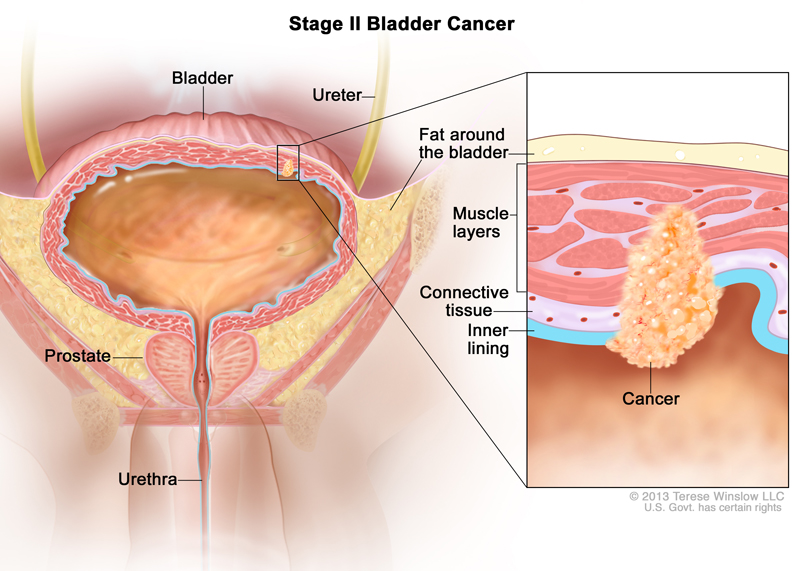- Stage 2 Bladder Cancer
Overview
Stage 2 Bladder Cancer diagnosis means that the Cancer has spread to the muscle layer of your bladder, shown here on the right in pink, but the cancer has not spread to the tissues around the bladder or any other organ.
What Tests Will I Need and Why?
Urine, Blood and Imaging tests are done to understand your general health, confirm your diagnosis and determine your cancer stage.
Tissue analysis is also typically done through a biopsy to identify the cancer cell type, which is critical to finding the best treatment option for you.
If your treatment team has not already performed tests to determine your cancer’s features, please ask your doctor when these tests will be performed.
Re-read this summary as needed and then tap, “Compare My Treatment Options Now“. Our unique Comparison Page will help you understand your FDA-approved treatment options including, who can help you pay for your treatment, where and how each is given and what side-effects you may experience.

National Institute of Health/ treatment-bladder
Recommended Bladder Cancer Diagnosis Videos

Understanding Your Bladder Cancer
An Easy to Follow Overview

Understanding Your Cancer Diagnosis
What Are Your Goals & More

How Cancer Spreads
Metastatic = Advanced

Diagnosing Your Cancer
How Does a CT Scan Work?

Diagnosing Your Cancer
How Does a PET Scan Work?

Exercise! You Can Do It
Reducing Side Effects & More
Commonly Searched Questions
Stage 2 Bladder Cancer Symptoms
- Blood in urine
- Urinating multiple times in a night
- Pain while urinating
- Difficulty urinating with a low-pressure stream of urine
- Pain in the abdomen
Source: Cancer.org
Stage 2 Bladder Cancer Treatment
- Surgery to remove the Bladder Cancer through the tube that carries urine from the bladder (urethra)
- Chemotherapy after surgery given directly into the bladder
- External radiotherapy with or without chemotherapy
- Immunotherapy helps your immune system identify and kill the Bladder Cancer. BCG is the most commonly used immunotherapy for this Stage
- A Clinical trial with a new treatment
Source: Cancer.gov
Stage 2 Bladder Cancer Survival Rate
Source: Cancer.gov
Stage 2 Bladder Cancer Recurrence Rate
Source: Cancer.gov
Stage 2 Bladder Cancer Prevention
- Avoid Tobacco: Smoking is the most significant risk factor for bladder cancer. Quitting smoking or avoiding tobacco products can greatly reduce the risk of developing bladder cancer.
- Limit Exposure to Carcinogens: If you work in environments where you are exposed to industrial chemicals (such as those used in the dye, rubber, or chemical industries), using proper protective equipment and following safety guidelines can help reduce your risk.
- Stay Hydrated: Drinking plenty of fluids, particularly water, can help flush out potentially harmful substances from the bladder and may lower the risk of bladder cancer.
- Healthy Diet and Exercise: Maintaining a healthy diet and engaging in regular physical activity can contribute to overall well-being and might help reduce cancer risk.
- Regular Medical Check-ups: For individuals at higher risk of bladder cancer or those with a history of bladder cancer, regular follow-ups and screenings are important for early detection and management.
Source: Cancer.org
Stage 2 Bladder Cancer Definition
- Stage 2A: The cancer has invaded the inner muscle layer (muscularis propria) but remains confined to the bladder.
- Stage 2B: The cancer has invaded the outer muscle layer but still has not reached nearby lymph nodes or other distant sites.
Source: Cancer.gov















